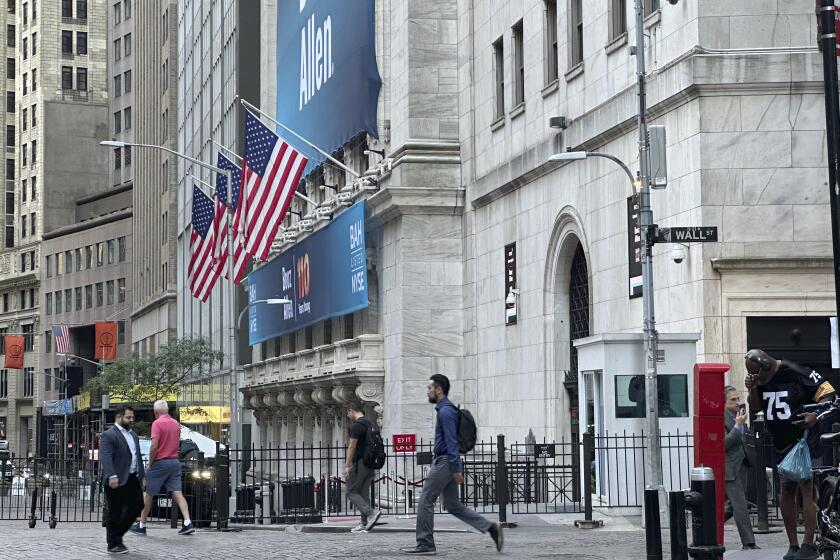Internet, Formerly a Lifeline for the Disabled, Is Getting Tangled Up
- Share via
NEW YORK — It was a bright day when Norman Coombs went blind.
In October 1940, he was getting into boyish mischief in a neighborhood park when a wayward stick poked his eye, leaving him blind.
As a student, Coombs had to rely on others to read to him. As a professor of history at the Rochester Institute of Technology, he couldn’t look up the book he wrote.
But with the help of computers, Coombs taught classes by e-mailing and chatting online with students, many also disabled. And he found his book, “The Black Experience in America,” in an online catalog--an experience he called “strangely affirming.”
To use his computer or the Internet, Coombs, 65, a professor emeritus at RIT, relies on a program that speaks text at a breathless 400 words per minute. It rips through Internet texts, offering Coombs the same access to the global network as everyone else.
Now, however, his program often gets tongue-tied, tripping over complex documents on the World Wide Web. That’s the part of the Internet with video, pictures, fancy design--even some audio.
While the Web is expanding at a lickety-split pace for those with hot computers and all their senses, it might well be shrinking just as fast for others. For the 10.2 million visually impaired and 10.8 million hard of hearing, the Internet is going dark and silent.
Coombs blames the setback on too-fast development by marketers and designers eager to promote the Internet as rich, engaging and multimedia. “The typical guy designing computers and software is 25 years old and doesn’t think he will ever lose his eyesight,” he says.
Peter Wong may not be that young--he’s 36--but he knows what Coombs is talking about.
Wong is a software engineer at Microsoft, keeping the physically disabled in mind while he works to improve the popular Windows software. Windows currently runs more than 80% of PCs in the United States, using pictures and icons instead of text.
That’s a nightmare for someone like Coombs, who relies on his ears and his screen-reader. So Wong and his team are developing software that can recognize speech and caption audio and video clips.
Wong is motivated because he also is blind. He lost his sight at age 14 to glaucoma. Now, he says, his blindness offers a unique understanding of the difficulties that the blind encounter with the Web.
But he also understands how enabling the technology can be. Before the Internet, Wong faced the same problems Coombs did. He needed a Braille translation or someone to read for him. Now information is directly available online through screen-readers. “It’s more than a quantum leap,” Wong says. “It’s like going from being illiterate to literate.”
Michael Bloomfield, Wong’s engineering colleague at Microsoft, is particularly concerned about access for the hearing-impaired. Profoundly deaf, he cannot distinguish most sounds. But he monitors one site in particular that offers music and news in an all-audio format. “If AudioNet would provide captioning, then it would benefit me,” he says through a special telephone operator for the deaf. “It would also help people learning English.”
The Net is a dramatic doorway for the disabled who have been online since the mid-1980s. The Net started years before that, in 1969, as a Defense Department project involving four universities. In those days, it was just words, no graphics. So in the 1980s, with personal computers, the Net was easy enough for deaf people and screen-reading programs. For example, at Gallaudet University in Washington, D.C., the nation’s largest school for the deaf, campus e-mail became the best way to communicate.
Now e-mail carries opportunities for the disabled beyond academia into corporate America. Blind people can work from their homes, and deaf people don’t need interpreters or expensive equipment.
Those benefits can make a real difference for the nation’s 54 million physically disabled. “On the Internet, disability is irrelevant,” Microsoft’s Wong says. “If I don’t tell you, you wouldn’t know I was blind.”
When Apple introduced the Macintosh in 1984 and Microsoft followed with Windows soon after, computers started using pictures and icons instead of typed commands. In 1993, with the invention of the Web, the Net began to look a lot like Windows and the Mac.
Everything changed. The Internet had pictures and users could simply point, clicking their way through documents. Sighted people loved it. Blind people hated it.
Four years later, the Web-- afloat with millions of documents--is now mainstream, and sophisticated design is common. What the Internet gave to the disabled, commercialization is taking away.
Greg Vanderheiden aims to reverse that. He’s the director of Trace Research & Development Center in Madison, Wis., and a professor of industrial engineering at the University of Wisconsin there. He touts the tremendous potential of computers and the Internet for people with disabilities. “But when it starts getting fancy,” he warns, “you lose it.”
Early Web sites, like the rest of the Internet, were mostly text. But when they got fancier, screen-readers couldn’t handle them. Photos confuse the software. Tables and columns scramble the sentences. And some pages were nothing but graphics, rendering readers mute.
Vanderheiden should know. He’s been monitoring access for the disabled since 1971, when he helped a student with cerebral palsy communicate in class. After working with the student for two years, he founded the Trace center in 1973 and brought in like-minded researchers.
Their research laid the groundwork for organizations such as the Yuri Rabinsky Insight Foundation in Nashua, N.H., an advocacy group for the disabled.
Mike Paciello, foundation director since 1992, has proposed ways to make the Web more accessible. In April this year, he submitted the idea to the World Wide Web Consortium, an international group that sets Web standards.
If his proposal is accepted, software for building Web sites is likely to change. For instance, designers might regularly add descriptions to pictures or captions to audio clips. Descriptions for pictures could be inserted so that they couldn’t be seen but would be understood by screen-readers.
Such new standards could help everyone. Just look at census projections. Today, one in three Americans between 55 and 64 is physically disabled. Of those 75 and older, three in four are. And that’s where today’s computer-savvy Generation X-ers will fall in 2050, when a third of the population will be 55 or older.
The market for software that makes the Internet accessible is potentially huge. The nation’s disabled earn a staggering $714 billion a year, and traditionally they are quick to snap up new technologies.
RIT’s Coombs may be a typical spender. When he bought his new laptop computer last year, his screen-reader cost about $500. He plans to spend another $100 to upgrade when new software comes out next year.
Meanwhile, Coombs swings between optimism and pessimism. He hopes software companies will design accessible products that don’t need such added software as his reader. He lauds Wong’s team at Microsoft but notes how tiny that corner of the corporate giant is.
Computer industry leaders are aiming at the largest market they can reach quickly, Coombs says. “In the process, they’re not thinking of . . . people who are in various ways impaired.”






